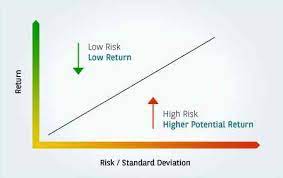Today's topic is "risk and return". Let's define what is risk and what is return first.
First of all, the theoretical return on investment usually refers to the "expected return", that is, the weighted average of various investment results and corresponding probabilities in the future. For example, toss a coin to guess the positive and negative, bet $5 each time with $2 earned correct and $1 lost wrong, then the expected return is 10%. That is, if one invests $5 each time, there will be 10% expected return. For a single time, the principal of $5 will either change to $7 or $4, and will not change to $5.5. However, if this investment can be repeated continuously, the final multiple continuous investment results will be around 10%.
In short, if the expected return of an investment is negative, it is rational not to participate, but irrational to participate. For example, lottery is a typical negative expected return for buyers and a positive expected return for sellers.

Then let's talk about risk. The risk mentioned above in investment theory is different from that in daily oral language. The risk of the latter usually means a loss event, while the former means the volatility of investment return, which is bidirectional not unidirectional. For example, for the time deposits of the four major banks, the interest rate is determined, the rate of return is also determined, and there is no fluctuation (regardless of other factors). The return of stocks is far wilder, which may be halved or doubled. Assuming that the interest rate of deposits is 5%, and there is a stock which has a 50% rate to rise 50% and fall 40% after a year, then the expected return of stocks is 5%. It can be seen that although the expected return on deposits and stocks is 5%, the volatility of stocks is obviously much larger. It is obviously not enough to measure with a single expected return.
In the real world, investment itself is a transaction of risk and return, and the relationship between the two is not isolated. If we simply divide the investment into four types according to the level of risk and return, they are:
(1) Low risk and low return
(2) Low risk and high return
(3) High risk and high return
(4) High risk and low return

It is most common in the public's real life of low risk and low return and high risk and high return, while it is less for low risk and high return and high risk and low return. Why?
Because there is an important factor behind risk and return: information.
How a stock rises and falls is almost random for retail investors. The final risk and return of retail investors cannot be accurately measured or predicted. They only know when the investment results are presented. If the stock is changed into the front and back of gambling coins, there are 50% to be doubled and 50% to lose. At this time, there is no asymmetry of information for market participants or gambling participants, and each other's cognition of winning is 50%.
But if they go back to the stock market, everyone may have different perceptions of market risk and return (loss). In extreme cases, an investor has learned the inside information about the suspension of trading of a certain stock for major asset restructuring. In his cognition, the probability of earning by buying this stock is far greater than the probability of losing. For him, this is a low-risk and high return investment, but other investors do not know. That is the low-risk and high return opportunity caused by information asymmetry.
Therefore, only accurate information can help investors judge what kind of type the investment is so that they can naturally reject high risk and low return, accept low risk and high return, and choose low risk and low return or high risk and high return according to their own preferences. In fact, the information most people get is inaccurate or even wrong, which eventually leads them to make wrong decisions. For example, many middle-aged and elderly people who are not familiar with internet financial management buy "financial product" in some high-risk P2P platforms, and are confused by the high interest income of daily interest payment, the so-called insurance company to ensure capital security, senior leaders' interview or TV advertising. They think it is a low-risk and high-yield investment, and the final principal is swallowed.
Ask yourself first when any "investment opportunity" appear front of you, "do I really know this investment variety? What is the ultimate destination of this investment? Do I trust the introducer of this investment opportunity? "If you can't answer any questions, it's better to give up.



